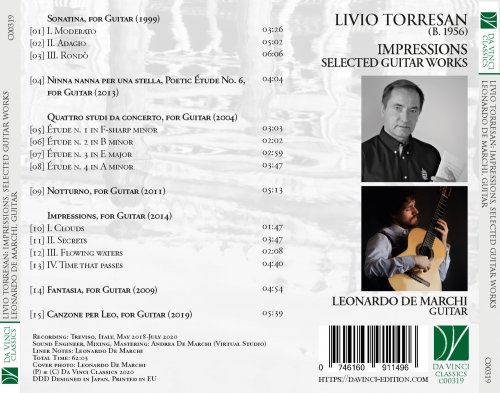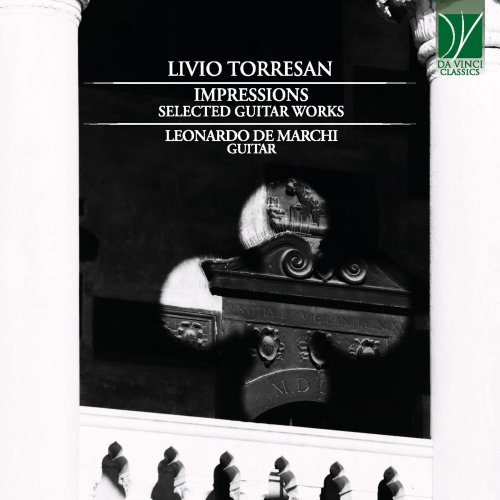
Leonardo De Marchi - Livio Torresan: Impressions (2020)
BAND/ARTIST: Leonardo De Marchi
- Title: Livio Torresan: Impressions
- Year Of Release: 2020
- Label: Da Vinci Classics
- Genre: Classical Guitar
- Quality: flac lossless
- Total Time: 00:58:37
- Total Size: 173 mb
- WebSite: Album Preview
Tracklist
01. Sonatina: I. Moderato
02. Sonatina: II. Adagio
03. Sonatina: III. Rondò
04. Ninna nanna per una stella, Poetic Étude No. 6
05. Quattro studi da concerto: No. 1 in F-Sharp Minor
06. Quattro studi da concerto: No. 2 in B Minor
07. Quattro studi da concerto: No. 3 in E Major
08. Quattro studi da concerto: No. 4 in A Minor
09. Notturno
10. Impressions: I. Clouds
11. Impressions: II. Secrets
12. Impressions: III. Flowing waters
13. Impressions: IV. Time that passes
14. Fantasia
15. Canzone per Leo

Is it still possible, in a world that has known all sorts of musical languages, to write music using linguistical and rhetorical forms, or models, from the euro-cultural tradition? What evolution is tonality capable of, and in what way does it marry the expressive requests of contemporaneity? These are the deep questions that guide Livio Torresan’s writing research (1957), a composer with a solid guitar training. Over the years, he has dedicated a large number of works to his instrument: this album presents a well thought essay, with the aim of summarizing twenty years of composition activity research threads.
The album begins with the mellow Sonatina (1999), with its three movements – an eloquent and flowing Moderato, a heart moving Andante and a Rondò with strong resonances – which immediately trace the coordinates of an expressive world that brings itself elements such as thematism and the constant use of a euphonic and consonant sound dimension. Regarding the Sonatina, the thematic ideas stand out against the harmonious background of nuances and shades, with sonorous waves that recall the lesson from Debussy’s String Quintet and De Falla’s Homenaje.
Less virtuously engaging (but perhaps for the same reason more subtly charming) is the Ninna nanna per una stella (Lullaby For A Star), from the Studi Poetici series (2013). Although mainly expanding on the higher range, the sound of the piece is well balanced since it uses, in a successful idiomatic manner, a rigorous broad harmonious conduct of the voices (a parti late).
With the demanding Quattro Studi Da Concerto (2004), the liason to the traditional concert studio genre is obvious, both in the strong harmonic tonal reference and in the degree of agility and power required from the interpreter. Unlike what usually happens with a traditional studio, in which the compositional center of gravity is focused on just the technical foundation (ligature, arpeggios, scales…), in the Quattro Studi Da Concerto the mechanical purpose seems not to be Torresan’s main concern. Each study does surely develop a precise gestural aspect, yet the goal of technical progress always seems to be transcended in the name of a superior musical reason.
With the logic of contrasts that animates the playlist, following the Quattro Studi Da Concerto we can find a natural place for the Notturno (2011), in which the importance of the thematicism of Torresan’s music emerges with even greater strength. In this sense, the preference for smooth cantabile lines does not mean renouncing to a compositional rigor: the initial theme in fact acts as generating material in the whole piece, weaving the narration of a coherence that does not affect the variety of the expressive situations.
The suite Impressions (2014) marks a certain return to the Debussian sounds that, above all, characterized the first two Tempi from the Sonatina. Torresan’s style becomes particularly descriptive here: a certain refined use of the tonal relationships allows the composer to outline four images (Clouds, Secrets, Flowing Waters, Time That Passes) in which each one suggested by the writing – be it the uncertain floating of clouds or the tumultuous flow of water – remains tinted by a sense of dreamy melancholy.
The atmospheres of the Fantasia (2009) give a far more extroverted result, with an impetuous rhythmic gait which presents as the most evident trait. The core of this piece is the central section, a two-part mouvement perpetuel with a tight imitative conduct and a continuous modulation; two substantial symmetrical episodes surround this section, with pyrotechnic triplet arpeggios alternated to solemn and hieratic chorals. The fundamental tonal reference, that fluctuates between parallel modes in G sharp minor and A flat major is never in question, though the continuous succession of tonalities leads the Fantasia to be an authentic harmonious and virtuous tour de force.
At the beginning we were wondering which possibile future direction could there be for the tonal language developments, according to Torresan: a possible answer is provided by the most recent Canzone Per Leo (2019). The thematic dimension relatively slides towards the background, in favour of a harmonious dissonant, restless and interlocutory development. Only at the end of the piece does the listener see the narrative tension unfold into a liberating C major triad: this is the most natural epilogue of a CD in which contemporaneity attempts to find its own reflection in the splendours of the past.
01. Sonatina: I. Moderato
02. Sonatina: II. Adagio
03. Sonatina: III. Rondò
04. Ninna nanna per una stella, Poetic Étude No. 6
05. Quattro studi da concerto: No. 1 in F-Sharp Minor
06. Quattro studi da concerto: No. 2 in B Minor
07. Quattro studi da concerto: No. 3 in E Major
08. Quattro studi da concerto: No. 4 in A Minor
09. Notturno
10. Impressions: I. Clouds
11. Impressions: II. Secrets
12. Impressions: III. Flowing waters
13. Impressions: IV. Time that passes
14. Fantasia
15. Canzone per Leo

Is it still possible, in a world that has known all sorts of musical languages, to write music using linguistical and rhetorical forms, or models, from the euro-cultural tradition? What evolution is tonality capable of, and in what way does it marry the expressive requests of contemporaneity? These are the deep questions that guide Livio Torresan’s writing research (1957), a composer with a solid guitar training. Over the years, he has dedicated a large number of works to his instrument: this album presents a well thought essay, with the aim of summarizing twenty years of composition activity research threads.
The album begins with the mellow Sonatina (1999), with its three movements – an eloquent and flowing Moderato, a heart moving Andante and a Rondò with strong resonances – which immediately trace the coordinates of an expressive world that brings itself elements such as thematism and the constant use of a euphonic and consonant sound dimension. Regarding the Sonatina, the thematic ideas stand out against the harmonious background of nuances and shades, with sonorous waves that recall the lesson from Debussy’s String Quintet and De Falla’s Homenaje.
Less virtuously engaging (but perhaps for the same reason more subtly charming) is the Ninna nanna per una stella (Lullaby For A Star), from the Studi Poetici series (2013). Although mainly expanding on the higher range, the sound of the piece is well balanced since it uses, in a successful idiomatic manner, a rigorous broad harmonious conduct of the voices (a parti late).
With the demanding Quattro Studi Da Concerto (2004), the liason to the traditional concert studio genre is obvious, both in the strong harmonic tonal reference and in the degree of agility and power required from the interpreter. Unlike what usually happens with a traditional studio, in which the compositional center of gravity is focused on just the technical foundation (ligature, arpeggios, scales…), in the Quattro Studi Da Concerto the mechanical purpose seems not to be Torresan’s main concern. Each study does surely develop a precise gestural aspect, yet the goal of technical progress always seems to be transcended in the name of a superior musical reason.
With the logic of contrasts that animates the playlist, following the Quattro Studi Da Concerto we can find a natural place for the Notturno (2011), in which the importance of the thematicism of Torresan’s music emerges with even greater strength. In this sense, the preference for smooth cantabile lines does not mean renouncing to a compositional rigor: the initial theme in fact acts as generating material in the whole piece, weaving the narration of a coherence that does not affect the variety of the expressive situations.
The suite Impressions (2014) marks a certain return to the Debussian sounds that, above all, characterized the first two Tempi from the Sonatina. Torresan’s style becomes particularly descriptive here: a certain refined use of the tonal relationships allows the composer to outline four images (Clouds, Secrets, Flowing Waters, Time That Passes) in which each one suggested by the writing – be it the uncertain floating of clouds or the tumultuous flow of water – remains tinted by a sense of dreamy melancholy.
The atmospheres of the Fantasia (2009) give a far more extroverted result, with an impetuous rhythmic gait which presents as the most evident trait. The core of this piece is the central section, a two-part mouvement perpetuel with a tight imitative conduct and a continuous modulation; two substantial symmetrical episodes surround this section, with pyrotechnic triplet arpeggios alternated to solemn and hieratic chorals. The fundamental tonal reference, that fluctuates between parallel modes in G sharp minor and A flat major is never in question, though the continuous succession of tonalities leads the Fantasia to be an authentic harmonious and virtuous tour de force.
At the beginning we were wondering which possibile future direction could there be for the tonal language developments, according to Torresan: a possible answer is provided by the most recent Canzone Per Leo (2019). The thematic dimension relatively slides towards the background, in favour of a harmonious dissonant, restless and interlocutory development. Only at the end of the piece does the listener see the narrative tension unfold into a liberating C major triad: this is the most natural epilogue of a CD in which contemporaneity attempts to find its own reflection in the splendours of the past.
Year 2020 | Classical | FLAC / APE
As a ISRA.CLOUD's PREMIUM member you will have the following benefits:
- Unlimited high speed downloads
- Download directly without waiting time
- Unlimited parallel downloads
- Support for download accelerators
- No advertising
- Resume broken downloads


